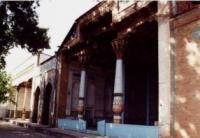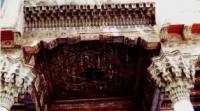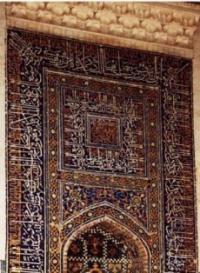You are here
Necropolis Khodja Akhrar.



Cultural-entertainment tours of Uzbekistan.
“It SMELLS ancient," - Dan Cahill”
Jude Watson.
Mystery tour in Samarkand.
Outstanding Sufi sheikh Khodja Ubaidallah Akhrar (1404 - 1490) was born in mountain kishlak of Bogustan near Tashkent. In 1426, Khodja Akhrar arrived to Samarkand, where he studied at the madrasah of Ulugbeg. Then he visited Bukhara and Herat.
In Herat, he took the Sufi way and within some years had studied at sheikh Said Tabrizi. The next stage of spiritual becoming of young Ubaidallah became study at adherent and disciple of Baha ad-Din Naqshband, Yakub Charhi, living in the Guissar mountains.
Receiving Sufi initiation from Yakub Charhi, Khodja Akhrar returned to Tashkent for realization of his mission. Here, he involved numerous adherents and by the mid-XV century, due to the highest spiritual authority, had been recognized as a leader of Central Asian Sufi brotherhood of "naqshbandiyyah".
His motto was: "The time has worsened, therefore the best business is to be at court of governors in order to help to the people and sick. "Naqshbandiyyah" headed by Khodja Akhrar supported the grandson of Miranshah, Temurid Abu-Said (1451 - 1469) to gain power in Maverannahr.
After that, sultan Abu-Said invited Khodja Akhrar to Samarkand and made him the aide. In 1454, Khodja Akhrar managed to stop a siege of Samarkand laid by the grandson of Shahruh, Abul-Kasim Babur, the governor of Khurasan.
In 1463, Khodja Akhrar stopped the mutiny of Ulugbeg grandson Muhammad Djuki raising against Abu-Said. When in the struggle for western Temurid domains, Abu-Said was killed in the battle with the Turkmen - Ak-Koyunli, his sons divided Maverannahr: Ahmad-mirza (1469 - 1494) received Samarkand, Mahmud-mirza - Bukhara, the father of Babur, Umar-sheikh - Fergana.
Sultan Ahmad-mirza (1469 - 1494) was murid of esteemed Khodja, who showed high respect to him". Umar-sheikh also "often enjoyed a talk with him. Esteemed Khodja called him his son".
In that period, Hussein Baiqara (1469 - 1506), the great-grandson of Umar-sheikh, took the power in Khurasan. Division of the Temurid state had strengthened influence of "naqshbandiyyah".
The peace treaty between Ahmad-mirza and his brother Umar-sheikh, supported by Tashkent khan Sultan Mahmud, became another bright demonstration of Khodja Akhrars influence. In Khurasan, Hussein Baiqara took outstanding poet and statesman Alisher Navoi to the throne, what strengthened influence of Herat "nakshbandiyyah", headed by ' Abd ar-Rahman Djami.
The main period of Khodja Akhrars spiritual and political activity was connected with Samarkand. In the suburbs of Samarkand there is his tomb. In the XVI century, the cemetery was formed around the sacred tomb.
The dahma, faced with marble was built specially for a group of tombs growing around Khodja Akhrars tomb. Among vertically standing tombstones of dahma, especially notable is white-marble stele of Khodja Akhrar with multi-lined Arabian epitaph.
Columned aivans and halls of non-synchronous mosques occupy the area at one of dahmas sides. The earliest one is the closest to dahma. It consists of a small premise and aivan. The mosque decor combines features of public dwelling and monumental architecture.
The wooden ceiling is painted in a style of dwelling houses and quarter mosques, and front walls are faced with ornamental sets from glazed and burnt bricks. Especially beautiful is mihrab, faced with perfect mosaics.
Authority:
Alexey Arapov. Samarkand. Masterpieces of Central Asia. Tashkent, San’at. 2004
Photos
Alexey Arapov.







